CRJ 13:4 - Out soon, subscribe now!
The main themes of this edition are resilience – whether societal, business, in critical infrastructure or psychological. We will also be taking a look at travel risk management, with advice on how to keep safe for businesses and travellers, in whatever capacity they might be called upon to undertake international travel. In addition, the thorny issue of humanitarian logistics in a crisis is examined, with articles from both the private sector and non governmental organisations.
This issue also explores security and terrorism, with an article looking at situational crime prevention as it can be applied to counter terrorism, an examination of hybrid attacks, and a look at the increasing vulnerability of mass warning systems when it comes to false alarms, whether deliberate or accidental.
Our R&D section features interviews with Romeo Durscher of DJI drones and Avichai Bakst of Waze, as well as news of research undertaken with Facebook, using geolocation data to understand evacuation, based on the structure of people’s social networks before, during and after hurricanes.
Read on for summaries of everything that's coming up. CRJ content is available online and in hard copy to subscribers only – click here for subscription details. And enjoy!
COMMENTS & NEWS
Daring to be different
The Crisis Response Journal has recently been reflecting what we do, and how we do it. Kirsty McKinlay-Stewart says now is the time to tell as many people as possible how CRJ, together with its international family of experts, can truly work together, navigating the choppy waters of crises as we go
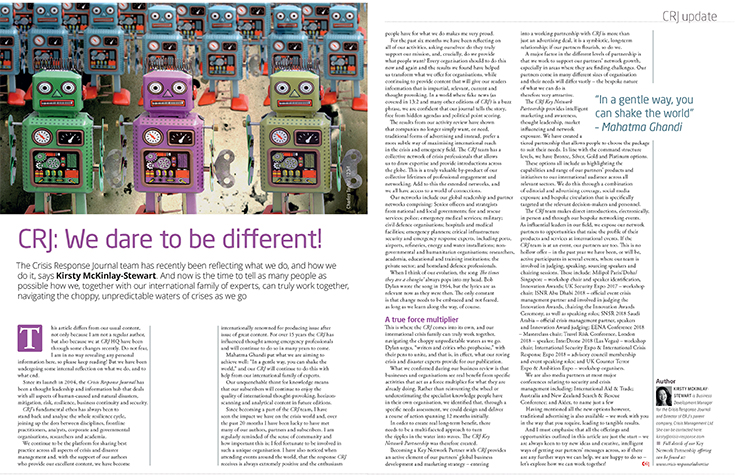
RESILIENCE: COMMUNITY, REFUGEES, INFRASTRUCTURE, SOCIETY
Operationalising resilience
Operationalising resilience techniques consist of two prior-event tasks and three response tasks, according to Robert Fagan in his exploration of this concept, which helps first responders to be ready for the impact and surge of an event
Community cohesion after tragic incidents
Dennis Davis examines how a disenfranchised and vulnerable community has evolved with cohesion and solidarity after the Grenfell Tower fire. Can these factors be harnessed and used to build greater community resilience in the future?
Growing resilience
Emily Hough speaks to Deborah Higgins, Head of the UK Cabinet Office Emergency Planning College, to learn more about her views on resilience, leadership and communities
Cascading consequences
We know about interdependencies between critical infrastructure systems, but how do we quantify the risks that are inherent within these systems, especially in terms of cascading consequences? Donya Hajializadeh announces a predictive model that uses resilience-driven decisions to provide key hazard scenarios for use in consequence planning
Urban resilience: Committing to change
Rade Rajkovchevski and Zoran Dorevski explain how the Republic of Macedonia’s capital city, Skopje, is prone to several disaster threats. This is why it has taken part in an urban resilience project that seeks to mitigate city risks in the face of climate change
Rohingya refugee crisis
James McArthur and Jørg Szarynski look at how geospatial technology has helped to make refugee camps safer by providing valuable timesaving information and key guidance
Psychosocial care in Syria, are we going in circles?
Psychosocial support in Syria requires momentum, money and a change in mindset, according to Erika Wichro, who says it also needs creative thinking, problem solving, inclusive dialogue, trust-capacity-resilience building, accelerated holistic healing and reconstruction
Closure after disasters

Jay Levinson and Abraham Dom look at helping bereaved people who have lost their loved ones in mass casualty disasters
Maritime urban disaster response
Brittany L card and David P Polatty contend that naval forces and platforms, especially amphibious ready groups, will increasingly play a critical role in supporting maritime-based disaster response operations
Globalism and world security
Globalism is essential to make the world a safer place, says Monique M Chouraeshkenazi; but more work is needed as citizens are witnessing previously effective international collaboration slowly disintegrating
SECURITY & TERRORISM
Situational crime prevention – thinking like a terrorist?
There is a tendency to consider situational prevention only in terms of target hardening when, in fact, it offers a more expansive range of options, explains Brian Dillon
Hybrid warfare as a societal threat
Intervention in foreign elections, ongoing influence operations targeting populations, especially in Eastern Europe, the Balkans and the Balkan states, along with the slow burning war in the Ukraine, are all symptoms of a new societal security environment, warns Ørjan Karlsson
Societal resilience in the face of malicious actors
Christo Motz interviews Itay Gil on public preparedness for terrorist and marauding firearms attacks
False alarms and mass alerts
Social media and automated technology can amplify mass warning messaging systems, helping them to reach more people, more rapidly. But what happens when mass warning messages are made in error, or are deliberately faked? Lina Kolesnikova investigates
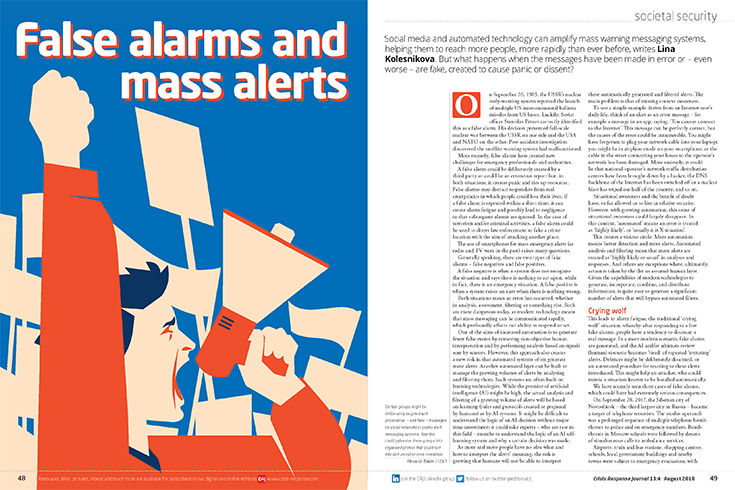
We’ve had a data breach. Let’s not tell anyone…
So, you have had a data breach. Do you fix it and keep quiet, or tell the world and risk the consequences? And should you disclose a breach if you are not legally obliged to? Tony Jaques discusses
Online enforcement
Jason Daniels looks at how partnerships and collaboration in online enforcement are helping to keep consumers safe from dangerous and fraudulent products, while protecting the brands of its clients. And the key to all of this is co-operation
HUMANITARIAN CARGO LOGISTICS
Volga Dnepr hosts event to discuss humanitarian cargo and logistics
Nicola Webb, Stuart Smith and Emily Hough report on a fascinating round-table event, hosted by Volga Dnepr at the Farnborough International Airshow, which explored the complex interactions between the private sector and non-governmental organisations involved with humanitarian cargo and logistics in emergencies
Logistical challenges for small NGOs
Stuart Lane of Team Rubicon outlines some of the challenges encountered by small, start-up disaster response organisations, drawing examples from the response to the hurricanes that struck the Caribbean in 2017
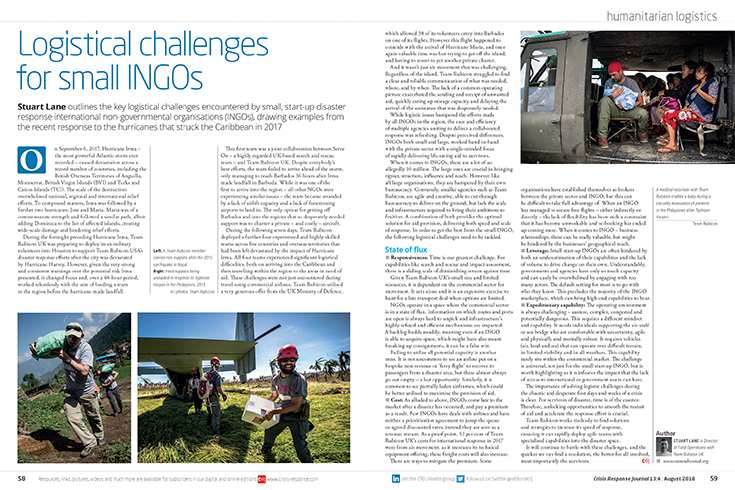
A global aviation resource hub
Emily Hough speaks to Pauli Immonen of Aviation sans Frontières to learn more about how it can help during the complex – and sometimes fraught – interaction between NGOs and the aviation cargo industry when a disaster has occurred
Big data and analytics for humanitarian logistics
The humanitarian sector has a great opportunity to apply the advances pioneered by the commercial world in using big data and analytics for logistics and supply chain services, writes David Prior
TRAVEL RISK MANAGEMENT
Beyond the smoke and mirrors of travel risk management
There was a time when trying to convince organisations they needed a risk management system to protect their travelling staff was like pulling teeth. Now, a whole industry has been built around the subject. But is it all smoke and mirrors? Lloyd Figgins provides some practical advice
Low threat, high fear
International travel and tourism are still growing, despite political instability, terrorism and crises, says Rob McAlister. But what are the effects of these events in terms of sector resilience?
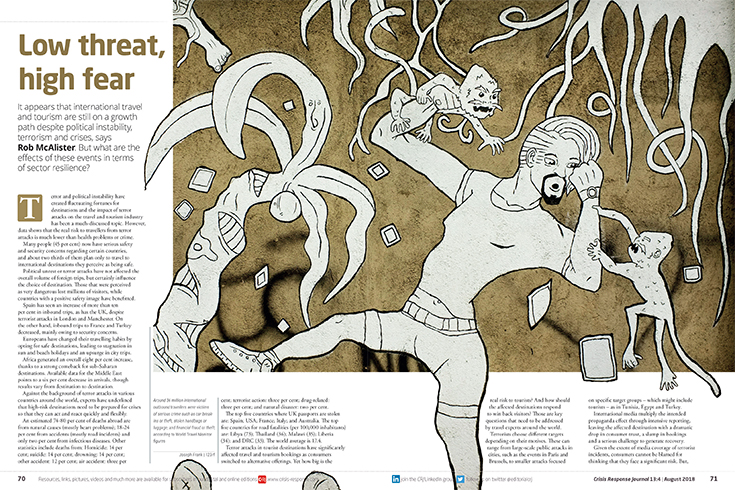
Beware the negligence trap
International employers are potentially liable for the safety of their staff, whether they are working in Mumbai, London or Buenos Aires. Richard C Pendry asks, your organisation is up to scratch?
Spotting trouble at airports
Casey Brunelle details the story of the Airport Watch programme and the invaluable support that volunteers provide for low cost, sustained public safety at airports
Travel risk planning
Car damage scams in Sicily, females targeted for theft in Dublin, follow-home armed robberies in South Africa and tourists kidnapped in the Philippines… How can you reduce your chances of being targeted? Paul Higgins says planning is the answer
Get your packing list together
Familiarity can breed contempt when travelling, but you should be constantly alert to avoid danger, both on and off duty. And always make sure you have a plan to survive, according to Colin McGowan and Mike Greville
Air crash in Nepal
Peter McMahon speaks to Suneeta Bhardwaj of the Aviation Rescue Firefighting Service at Tribhuvan International Airport after a major incident in which an aircraft crashed on landing
CRJ R&D
The sky’s not the limit:Drones and public safety
CRJ often reports on how drones are being utilized in safety and security applications. But the future possibilities are even more extensive, according to Romeo Durscher of drone giant DJI, speaking to Emily Hough
Social ties are the ‘engine’ of resiiience
Danaë Metaxa, Paige Maas and Daniel P Aldrich describe how they worked with Facebook, using geolocation data to understand evacuation, based on the structure of people’s social networks before, during and after hurricanes
Reducing congestion, saving lives
Emily Hough speaks to Avichai Bakst from Waze to trace the journey of this crowdsourced, community-driven app – originally designed to help people get to and from work more easily – to its current evolution where it is helping in disaster and emergency response
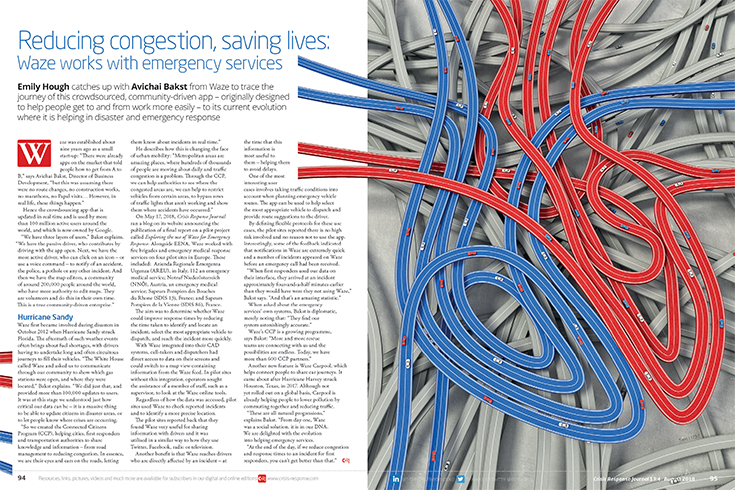
Events
News on the International Disaster Response Expo, Milipol Qatar, Interdrone 2018 and full diary dates listings
Frontline: Mapping the plastics scourge
Claire Sanders speaks to Peter Kohler, founder of the Plastic Tide, a project that explores the relationship and impact of plastics on communities and individuals by using drone technology and machine learning to detect and map plastics on beaches